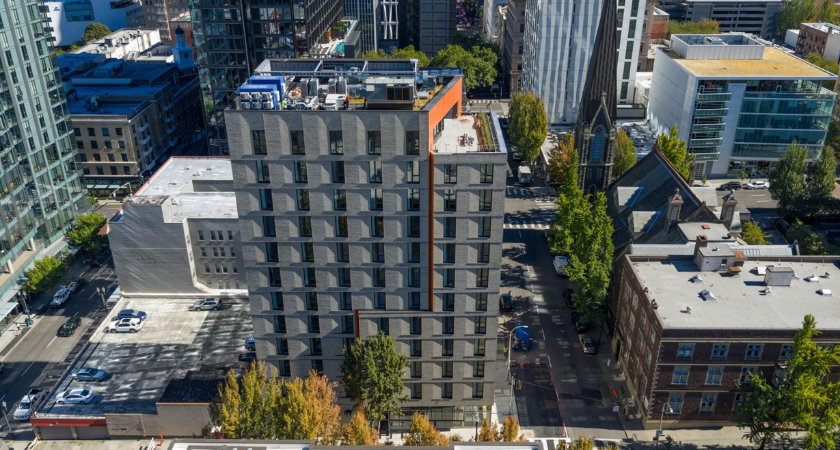
Residents have officially begun moving into Oregon’s tallest mass timber building, the Julia West House — a landmark 12-story affordable housing tower located in downtown Portland. The development represents a major step forward in both sustainable architecture and affordable housing innovation, showcasing how mass timber can be used to meet community and environmental goals simultaneously.

Built on a formerly underutilized 5,000-square-foot lot, the new building provides 90 fully furnished apartments — 60 studios and 30 one-bedroom units — specifically for individuals earning 30% or less of the area median income, or about $26,070 in 2025 for a one-person household. At just over 44 meters tall, the tower now holds the title of Oregon’s tallest wooden building.
The project was initiated through a partnership involving Community Development Partners (CDP), Holst Architecture, Walsh Construction, and KPFF Consulting Engineers. It was made possible through a mix of public and private financing, including a 4% Low-Income Housing Tax Credit, USDA Wood Innovations funding, and a Portland Clean Energy Community Benefits Fund grant.
The origins of the project date back decades. The First Presbyterian Church of Portland acquired the property in the 1980s, originally the site of a single-family home named in memory of Julia West Lindsley, wife of the church’s first pastor. In 2024, the church sold the site to CDP, which broke ground on the project that same year.
“This moment represents the culmination of years of work and vision,” said Eric Paine, Chief Executive of Community Development Partners, who noted the unique challenge of designing with timber at scale. “It was the first time we had used cross-laminated timber in a multi-storey building, and it was the tallest building that CDP has ever developed.”
The Julia West House is among the first “Type IV-B” timber towers built under Oregon’s modernized building code. Oregon became the first state in the U.S. to establish specific regulations for mass timber construction in 2018. Before those updates, timber structures were limited to six stories; the new code now permits Type IV-A buildings up to 18 stories, IV-B up to 12 stories, and IV-C up to nine stories.
“This project is a great example of how to economically build high-performing, desirable housing for people who desperately need it,” said Christopher Pitt, associate engineer at KPFF.
.jpg)
The tower’s 90 units are designed to serve some of Portland’s most vulnerable residents — including seniors and members of Black, Indigenous, and People of Color (BIPOC) communities. According to local data, nearly one in four of Portland’s unhoused residents are aged 55 or older, with BIPOC individuals disproportionately represented among that population.
The building includes a community room, rooftop patio, lounge, communal kitchen, laundry facilities, and secure bike storage, creating a sense of community and belonging. Onsite offices provide property management, resident services, and case management support to ensure long-term housing stability.
Fortifying its role as a beacon of inclusive and sustainable urban design, the Julia West House symbolizes the evolving potential of mass timber to address social and environmental priorities simultaneously.
“This project demonstrates that sustainable materials can meet critical housing needs,” said a spokesperson for Holst Architecture, emphasizing that mass timber not only reduces carbon emissions but also enhances construction efficiency and indoor air quality.
The Julia West House is part of a growing wave of mass timber projects transforming urban skylines across the U.S., particularly in the Pacific Northwest, where local timber resources and environmental awareness have driven innovation.
With Oregon continuing to lead the way in green building policy and affordable housing design, the Julia West House stands as both a symbol of progress and a blueprint for future development — where climate-conscious materials and community-driven missions intersect to create lasting change.
Originally reported by Rod Sweet in GCR.